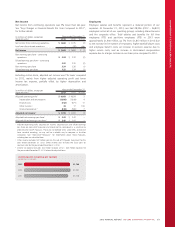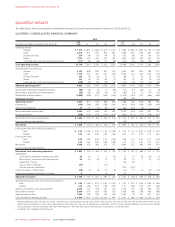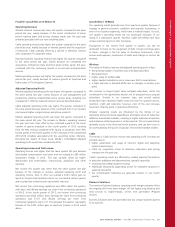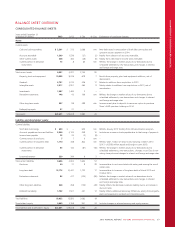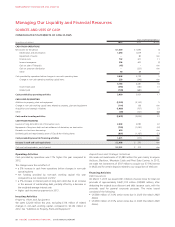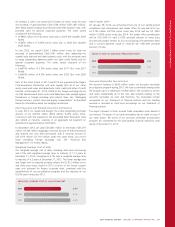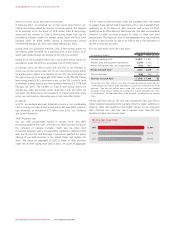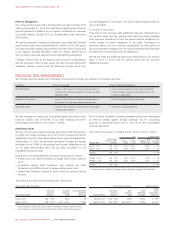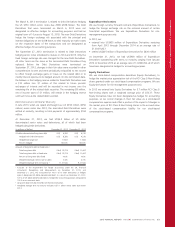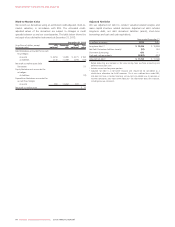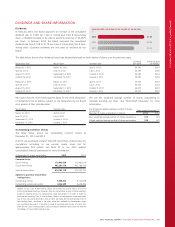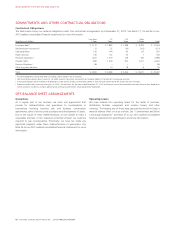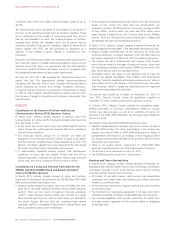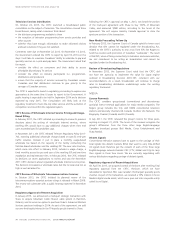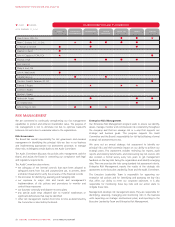Rogers 2013 Annual Report Download - page 66
Download and view the complete annual report
Please find page 66 of the 2013 Rogers annual report below. You can navigate through the pages in the report by either clicking on the pages listed below, or by using the keyword search tool below to find specific information within the annual report.
MANAGEMENT’S DISCUSSION AND ANALYSIS
Pension Obligations
Our retiree pension plans had a funding deficit of approximately $172
million at December 31, 2013. We have been making special minimum
monthly payments in addition to our regular contributions to eliminate
the pension liability. During 2013, our funding deficit was reduced by
$162 million.
The special payments, including contributions associated with benefits
paid from the plans, were approximately $7 million in 2013. We expect
our total estimated funding requirements to be $96 million in 2014 and
to be adjusted annually thereafter, based on various market factors
such as interest rates and expected returns and staffing assumptions.
Changes in factors such as the discount rate, increase in compensation
and the expected return on plan assets can affect the accrued benefit
obligation, pension expense and the deficiency of plan assets over
accrued obligations in the future. See Critical accounting estimates for
more information.
Purchase of Annuities
From time to time we have made additional lump-sum contributions to
our pension plans, and the pension plans have purchased annuities
from insurance companies to fund the pension benefit obligations for
certain groups of retired employees in the plans. Purchasing the
annuities relieves us of our primary responsibility for that portion of
the accrued benefit obligations for the retired employees and eliminates
the significant risk associated with the obligations.
We did not make any additional lump-sum contributions to our pension
plans in 2013 or 2012, and the pension plans did not purchase
additional annuities.
FINANCIAL RISK MANAGEMENT
We normally use three categories of derivative instruments to manage risks related to our business activities:
Categories The risk it manages Types of derivative instruments
Debt Derivatives • Impact of fluctuations in foreign exchange rates on
principal and interest payments for US denominated
long-term debt
• Cross-currency interest rate exchange agreements
• Forward foreign exchange agreements (from time
to time, as applicable)
Expenditure Derivatives • Impact of fluctuations in foreign exchange rates on
forecasted US dollar denominated expenditures
• Forward foreign exchange agreements
Equity Derivatives • Impact of fluctuations in share price on stock-based
compensation expense
• Total return swap agreements
We also manage our exposure to fluctuating interest rates and we have
fixed the interest rate on 95.3%of our debt including short-term
borrowings at December 31, 2013 (2012 – 100%).
Debt Derivatives
We use cross currency interest exchange agreements (Debt Derivatives),
to hedge the foreign exchange risk on all of the principal and interest
obligations of our US dollar denominated senior notes and debentures.
At December 31, 2013 we used Debt Derivatives to hedge the foreign
exchange risk on 100%of the principal and interest obligations on all
our US dollar denominated debt. We use Debt Derivatives for risk
management purposes only.
During 2013, we completed Debt Derivatives transactions as follows:
• entered into new Debt Derivatives to hedge senior notes issued in
2013
• terminated existing Debt Derivatives and entered into Debt
Derivatives with different terms to hedge existing senior notes
• settled Debt Derivatives related to senior notes that matured during
the year.
All of our Debt Derivatives currently outstanding have been designated
as effective hedges against foreign exchange risk for accounting
purposes as described below and in note 20 to the consolidated
financial statements.
New Debt Derivatives to Hedge Senior Notes Issued In 2013
Effective date
US$ Principal/
notional amount
(millions)
US$ Hedging effect
Maturity
date
Coupon
rate
Fixed
hedged Cdn.$
interest rate 1
Cdn$
equivalent
(millions)
March 7, 2013 US$ 500 2023 3.00%3.60%$ 515
March 7, 2013 US$ 500 2043 4.50%4.60%$ 515
Subtotal US$ 1,000 $ 1,030
October 2, 2013 US$ 850 2023 4.10%4.59%$ 877
October 2, 2013 US$ 650 2043 5.45%5.61%$ 671
Subtotal US$ 1,500 $ 1,548
1Converting from a fixed US$ coupon rate to a weighted average Cdn$ fixed rate.
Terminated and Replaced Existing Debt Derivatives
Terminated Debt Derivatives New Debt Derivatives Hedging effect
Termination date
Notional
amount
(millions)
Original
maturity
date
Cash settlement
payment
(millions) Date entered
Derivative
amount
(millions)
New
maturity
date
Fixed
weighted
average 1
Fixed
Cdn$
equivalent
(millions) 2
Mar 6, 2013 US$ 350 22018 Nil Mar 6, 2013 US$ 35022038 7.62%$ 356
Sep 27, 2013 US$ 1,075 3,4 2014 – 2015 $ 263 Sep 27, 2013 US$ 1,07532014-2015 7.42%$ 1,110
1Converting from a fixed US$ coupon rate to a weighted average Cdn$ fixed rate.
2Converting from a fixed US$ principal amount to a fixed Cdn$ principal amount.
62 ROGERS COMMUNICATIONS INC. 2013 ANNUAL REPORT



